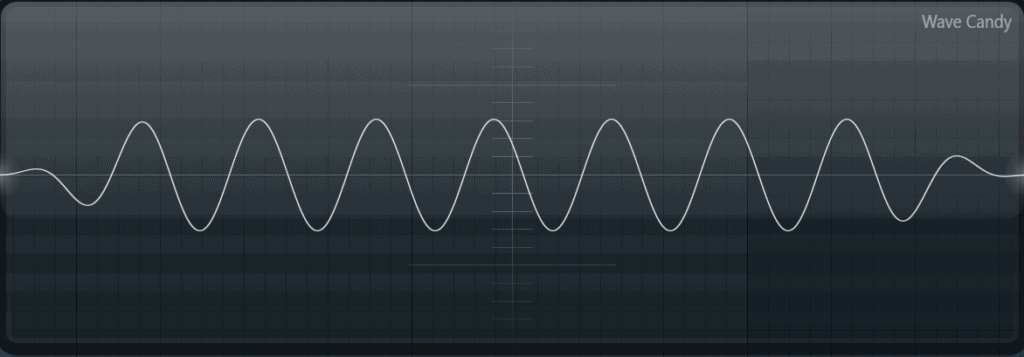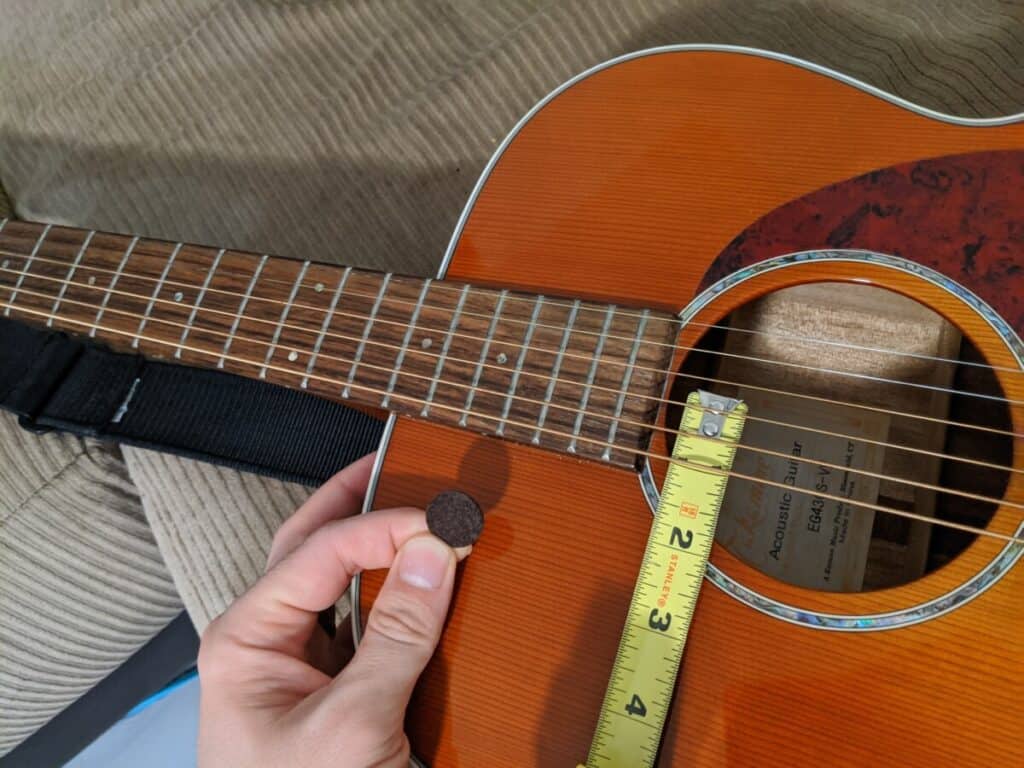This post contains affiliate links. We earn commissions if you purchase products from retailers after clicking on a link from our site. As an Amazon Associate, we earn from qualifying purchases.
With the dozens of guitar string types out there an inevitable question pops up: What’s the difference between getting lighter (thinner) gauge guitar strings and the heavier (thicker) gauge guitar strings? Specifically are the thicker strings louder?
Thicker guitar string gauges are perceived louder than thinner guitar string gauges due to more overtones, greater amplitude due to more energy being released as well as longer sustain.
So how much of a difference does thicker guitar strings actually make? Is the difference strong enough to make a noticeable effect? Well, let’s figure all of this out.
Why Thicker Guitar Strings Are Louder
Loudness is an interesting term for music because loudness doesn’t necessarily translate to amplitude. Amplitude is a measurement of the power of a signal. How loud something is perceived (often) goes up when amplitude goes up, but amplitude isn’t the only thing that contributes to loudness.
So what does this mean and why does it relate to guitar strings? Some things (including guitar strings) will sound louder even if they are not technically a higher amplitude.
There are three big reasons why thicker guitar strings can sound louder than thinner guitar strings:
- Overtones
- Stiff strings have more energy
- Thicker strings sustain longer
I’ll go into depth on each of these points:
The Power of Overtones
An overtone is an additional tone associated with a fundamental tone.
(I’ve put a limiter on these samples to -10db. They are all the same amplitude)
So if you listen to a super simple sine with basically no overtones, for example:
By the way, looking for recording equipment and musical instruments? Check out Sweetwater.com for microphones, monitors, audio interface or any other recording gear that you could ever need. (Affiliate Link)
By the way, looking for a guitar? Check out GuitarCenter.com for acoustic, electric, or classical guitars as well as all the guitar gear you could ever need. (Affiliate Link)
That’s what this note sounds like, take a look at this picture to see what that looks like.

That’s what it looks like through the Oscilloscope–which gives us an idea of what the wave looks like. But what about a Spectrum analysis?

Notice how the note is only one frequency– it has no overtones.
The pure sine wave sounds pretty loud to me. However, what if we add some overtones?
Now what if we apply some distortion to this sine wave but keep the limiter to -10 db, we get something that sounds like this: (Make sure you turn down the volume on your speakers since this sounds quite loud)
That’s the distorted sine wave sound. If you compare the two sounds–even though they are the same volume (amplitude), the distorted sine wave sounds WAY louder! This is what the distorted wave form looks like:

Notice the distorted sine wave form, it now has three different peaks! Let’s check out its spectrum analysis:

Whoa! Look at all those overtones! The sine wave used to have a single frequency, but now it has 19 overtones!
TL;DR: More overtones sound louder than less overtones, even if the volume is the same
Guitar String Overtones
This same principle applies to guitar strings. The thicker guitar strings produce more overtones than thinner guitar strings.
If you have a piano handy, you’ll notice this exact same phenomenon. Play the lowest note on the piano–notice how it sounds really buzzy and you can barely discern the note? The lowest notes on the piano have the thickest strings and the most overtones. Now play the highest note on the piano. You can easily pick out the note and the note sounds more bell-like, which is another way of saying it has less overtones and is more pure.
On top of that, think of the 6 strings on your guitar right now. The highest pitched (the E on the top) string is just a metal wire, while the lower guitar strings are thicker versions of the higher guitar strings with the addition of another wound wire around the core wire.
These wound wires provide a bumpiness to the guitar string, which will create more overtones.
In fact, the type of wound wires can even affect the sound dramatically, and even how comfortable it is to play the strings. There are different types of wound wires, some are flat (often used for base or jazz guitarists), others are “half-round” which are just filed down rounds. You can learn more about the different wound wires here at my other post and learn what’s different about them.
Guitar String Overtone Example
So.. that’s the theory… I decided to test this for myself! I got out my guitar and measured the low E2 String, the G String tuned to low E2, and just for fun, I did the high E4 string. I did a spectrum analysis on all three to see if there was any difference in overtones.
This is my low E string which is .053 inches in diameter and tuned to E2 (standard guitar tuning).

Take note of the spread of frequencies! Instead of super distinct lines you see something more of a scatterplot.
As a comparison, I also played the G string which is of diameter .024 inches (half the diameter of the low E) string tuned to the low E2:

You can see the same breadth of overtones but they are not as strong, especially towards the high end.
Lastly, I also played E4 on the thinnest string of the guitar which had a diameter of .012 inches.

Matching up with conventional knowledge, you can see that the overtones are much thinner. It’s really fantastic when you compare the frequencies of the E2 and the E4, because you can see how the low E2 string wavers and has a very broad spectrum, in comparison to the E4 string which has very tight and solid frequencies.
TL;DR:
The thicker the guitar string, the more overtones. As we learned with the example above, more overtones means higher perceived loudness.
Thicker Strings = Stiffer Strings = Louder Strings
I had heard this many times before, that a thicker string is louder because it is stiffer. I decided to do my own experiment to test the theory.
I’ll give you a bit of a spoiler. The thickness of the string makes a noticeable difference in volume.
Materials used:
- Acoustic Takamine EG430S-VV Guitar
- Furniture Pad as a pick to factor out attack (as much as possible)
- Tape measure
- MXL V88 microphone

Method:
- Tune the 2nd and 4th strings to E2
- Get tape measure on the tuning peg side of the sound hole and line it up with the edge of the string as I was looking down at the string
- Pull back string on 12th fret with a furniture pad to try and remove as much attack as possible
- Release string when it has been pulled back 1/8th of an inch.
Here are the three samples:
Experiment Results
With my microphone at the same setting for all strings and not taking into account the attack (the plucking of the string), I got these results:
- 1st and thickest string at .053 inches in diameter came in at -9db.
- 2nd string down tuned to E4 at .042 inches in diameter came in at -15db
- 4th string down-tuned to E4 at .024 inches in diameter came in at -21db
The 4th string (which is still a wound string) was so loose when down-tuned to E2 you could see it vibrating like crazy, but it was much quieter than the higher tensioned E2 string at .053 inches in diameter.
So, to summarize, thicker strings produce higher volume than thinner strings if they are pulled back the same distance.
Experiment Discussion
Intuitively, this all makes sense. A tighter string has more energy. The tighter you make the string the more potential energy it stores. Just like if you were to continue to pull a rubber band the more potential energy you put into it.
If you pull back a loose rubber band and let go without building a lot of tension, it’s not going to shoot very far. If you pull back a rubber band with a ton of tension, it’s going to rocket off and probably nail someone in the face.
The key point here is it all depends on how hard you strike you strings. If you don’t adjust your playing style at all when you put on thicker strings, you will play at a higher volume (you will have to put in slightly more effort to pluck and strum the strings).
If however you back off your playing with thicker strings, then you may not notice any volume difference whatsoever.
Electric Guitars
So, this definitely seemed to be true for an acoustic guitar and it would make sense that the same thing would happen for an electric guitar–although instead of moving air an electric guitar makes noise through electrical disturbances. It follows that the harder you pull a string, the more disturbance is created. I haven’t tested this, though and it would be an interesting experiment.
Furthermore, electric guitarists play so loud it’s a lot harder to distinguish between ultra loud and super ultra loud, anyway.
Is The Difference In Volume for Heavy vs. Light String Gauges Noticeable?
One important thing about this. The difference between “extra light” gauges and heavy gauges will be noticeable, (a difference of around .09 inches) but the difference between “extra light” and “light” will not be a big difference at all. Even between “light” and “medium” guitar string gauges, the difference is around .04 inches.
That’s not a huge difference.
It’s likely that you won’t notice a large difference in volume from going from one set of guitar strings to another.
In fact, I asked this question to a community of guitarists, and about half of the 13 that answered said there was no difference in volume.
Even if there technically was a difference in volume, it seems that half of guitarists don’t even think it is noticeable.
The most likely scenario you’ll notice a significant difference is on an acoustic guitar going from extra light to heavy strings.
Thicker Strings Have More Sustain and Sustain Sounds Louder
Kind of a byproduct of this experiment I realized that the thicker guitar strings sustained their volume for longer than the thinner guitar strings.
The same principle applies to drum cymbals. The large ride if you hit it like a crash cymbal will sustain for a long time–while the splash cymbal has a high-pitched and short crash that dies out, quickly.
It turns out that our brains perceive long tones louder than short tones.
If the fire alarm went off with a brief half second klaxon and that was it, it wouldn’t feel very loud. But if the tone sounds and sustains it feels extremely loud.
The same applies to guitar strings to a lesser extent. Often we are making transition from note to note, but it is a subtle difference that can add to the loudness perception for thicker guitar strings.
